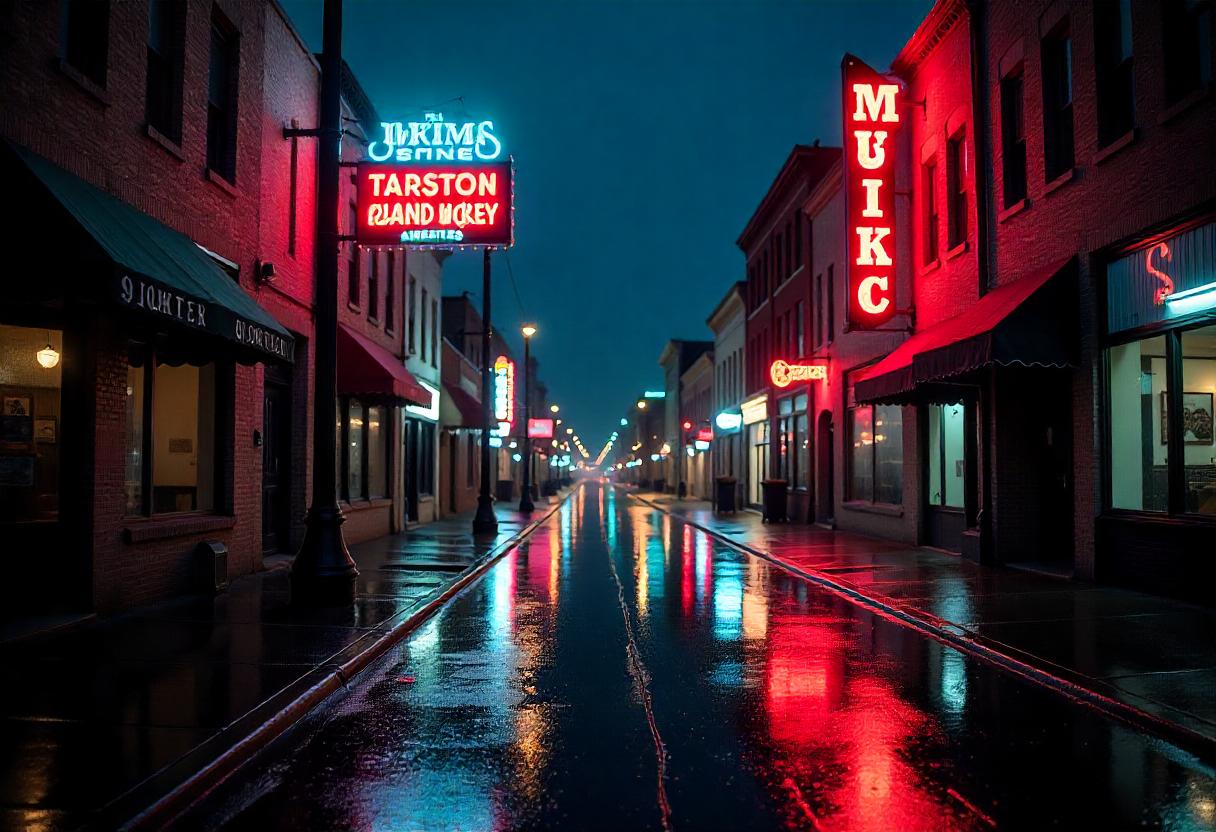
Music Row, the heart of Nashville’s music industry, is home to legendary recording studios and the iconic Nashville Sound that transformed country music.
Nestled in Nashville’s 16th and 17th Avenues South, Music Row is the epicenter of Music City’s recording legacy, where studios like RCA Studio B and Columbia’s Quonset Hut birthed countless hits. Since the 1950s, this vibrant district has drawn artists like Elvis Presley, Dolly Parton, and Johnny Cash, who recorded chart-topping songs in its historic spaces. The area, known as Music Square, houses record labels, publishing houses, and studios that shaped the Nashville Sound, a smooth blend of country and pop. Companies like Nashville Experience Tours offer guided visits, sharing stories of music history and behind-the-scenes magic. From iconic studios to the “Musica” statue, Music Row invites visitors to explore Nashville’s enduring musical heritage.
[](https://www.placemakr.com/blog/intro-to-music-row-nashville)Historic Recording Studios
Iconic studios like RCA Studio B and Columbia’s Quonset Hut on Music Row have produced thousands of hits, cementing Nashville’s status as a recording hub.
RCA Studio B: Home of 1,000 Hits
RCA Studio B, opened in 1957, is Nashville’s most famous recording studio, known as the “Home of 1,000 Hits.” Elvis Presley recorded over 200 songs here, including “Are You Lonesome Tonight,” with holiday lights strung up to set the mood, as noted by a tour guide’s anecdote. Dolly Parton’s “I Will Always Love You” and Roy Orbison’s “Only the Lonely” also came to life in this studio, listed on the National Register of Historic Places. Visitors can tour RCA Studio B through the Country Music Hall of Fame, experiencing its historic Steinway piano and vintage equipment. Nashville Experience Tours offers guided walks or van tours, providing insider stories about artists and the studio’s role in shaping Music City’s legacy.
[](https://www.countrymusichalloffame.org/experiences/studio-b)Columbia’s Quonset Hut and More
Columbia’s Quonset Hut, established in 1954 by Owen Bradley, was Music Row’s first recording studio, setting the stage for Nashville’s rise as a music hub. Patsy Cline’s “Crazy” and Bob Dylan’s “Blonde on Blonde” were recorded here, showcasing its versatility across genres. Though now closed, its legacy lives on in Music Row’s identity, as noted by the National Trust for Historic Preservation. Other studios, like Ocean Way Nashville, housed in a former church, and House of David, which welcomed Emmylou Harris and Roy Orbison, continue the tradition. These studios, blending historic charm with modern tech, attract artists worldwide. Tours reveal their stories, from secret passageways to innovative recording techniques, offering a glimpse into Nashville’s creative heart.
[](https://belleairmansion.com/blog/music-row-in-nashville-2023/)[](https://www.trolleytours.com/nashville/recording-studios)The Nashville Sound Legacy
The Nashville Sound, pioneered by producers like Owen Bradley and Chet Atkins, blended country with pop, revolutionizing music from Music Row’s studios.
Birth of the Nashville Sound
In the 1950s, producers Owen Bradley and Chet Atkins crafted the Nashville Sound, a polished style blending country’s twang with pop’s smooth vocals and strings. This sound, born in studios like RCA Studio B and Quonset Hut, made country music mainstream, with hits like Patsy Cline’s “Crazy” and Jim Reeves’ “He’ll Have to Go.” Bradley’s innovative techniques, such as adding lush orchestration, attracted diverse artists like Bob Dylan and the Everly Brothers. The Nashville Sound reshaped the industry, as noted by the Country Music Hall of Fame, making Music Row a global recording destination. Guided tours share stories of this era, highlighting how Nashville became a cultural powerhouse. Nashville Experience Tours connects visitors with guides who bring this history to life.
[](https://www.countrymusichalloffame.org/experiences/studio-b)[](https://www.trolleytours.com/nashville/recording-studios)Influence on Modern Music
The Nashville Sound’s legacy continues to shape modern music, with Music Row studios like Black River Entertainment blending analog warmth with digital innovation. Contemporary artists like Chris Stapleton and Miranda Lambert record in historic spaces like RCA Studio A, preserving the district’s heritage, as highlighted by Historic Nashville, Inc. The area’s creative community, including songwriters and producers like Charlie Handsome, ensures Music Row remains a hub for diverse genres, from hip-hop to country pop. Visitors can explore this evolution through tours that visit active studios and landmarks like Owen Bradley Park. These experiences reveal how Music Row’s past inspires today’s hits, connecting yesterday’s legends with tomorrow’s stars in Nashville’s ever-evolving music scene.
[](https://www.placemakr.com/blog/intro-to-music-row-nashville)[](https://www.historicnashvilleinc.org/get-involved/save-music-row/)Why Visit Music Row?
Visiting Music Row offers an immersive journey into Nashville’s recording history, with tours providing insider stories and hands-on studio experiences.
Immersive Studio Tours
Music Row tours, like those offered by Nashville Experience Tours, immerse visitors in Nashville’s recording legacy, visiting studios where legends made history. RCA Studio B tours, booked through the Country Music Hall of Fame, let you stand where Elvis recorded or even try recording your own track. Knowledgeable guides, like Nashville Joe, share anecdotes about artists and the recording process, from mixing to mastering, as noted in Viator reviews. The “Musica” statue and Owen Bradley Park offer photo ops, while historic buildings house music businesses, blending past and present. Book a tour via Nashville Experience Tours to explore Music Row’s vibrant history, making your visit a deep dive into Music City’s soul.
[](https://nashvilleexperiencetours.com/musicrowtour/)[](https://www.viator.com/tours/Nashville/Nashville-Music-Row-Walking-Tour/d799-90684P1)Tips for Exploring Music Row
To fully enjoy Music Row, plan ahead for a memorable experience. Book studio tours in advance, as RCA Studio B’s limited capacity fills quickly, especially during peak seasons. Wear comfortable shoes for walking tours, and bring a camera for landmarks like the “Musica” statue. Van tours, which are wheelchair-accessible, offer a relaxed option for covering more ground, as noted by Nashville Experience Tours. Visit during weekdays to avoid crowds, and check for events like record release parties at Bobby’s Idle Hour, a local honky-tonk. Bring water and snacks for longer tours, and engage with guides for insider stories about Music Row’s past. These tips ensure you experience the heartbeat of Nashville’s music industry, leaving with a deeper appreciation for its recording legacy.
[](https://nashvilleexperiencetours.com/musicrowtour/)[](https://www.nashvillepedaltavern.com/blog/music-row-nashville-guide-the-locals-side-of-nashville/)